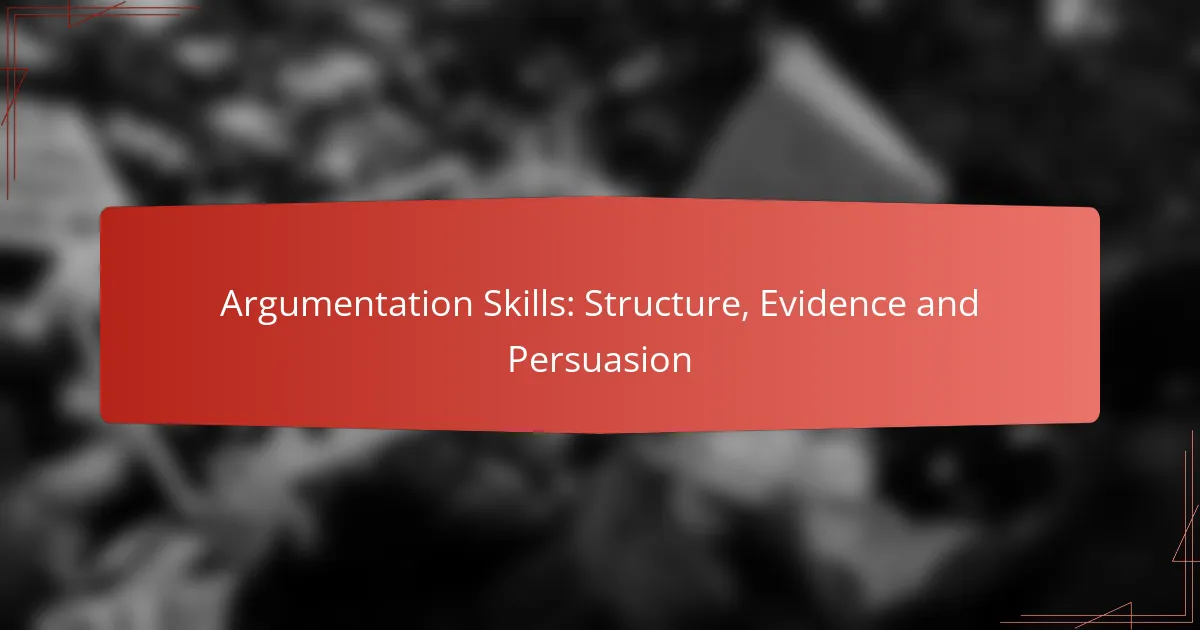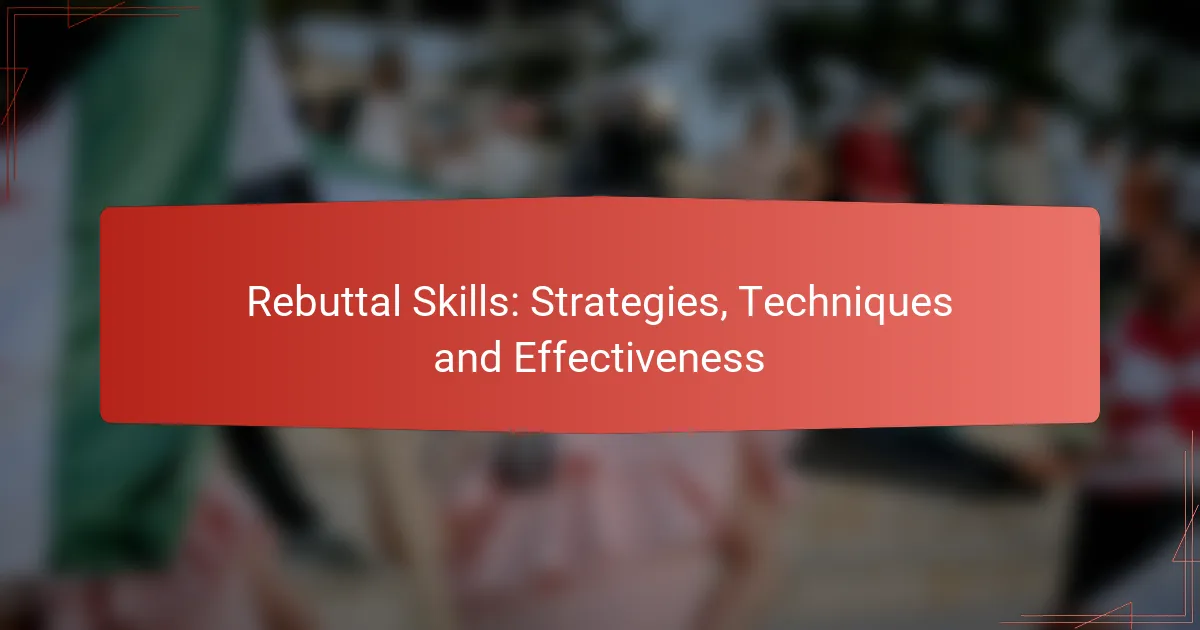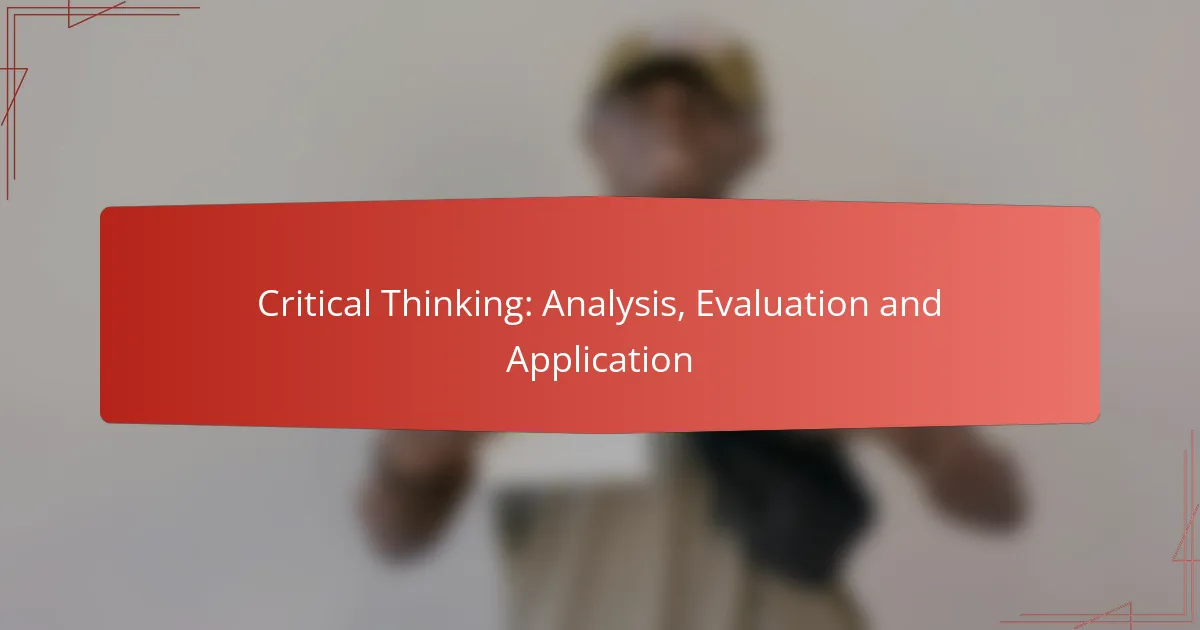Mastering argumentation skills is essential for effective communication in the workplace, enabling individuals to present their ideas with clarity and persuasion. A well-structured argument, supported by credible evidence, not only enhances the speaker’s credibility but also engages the audience, making it more likely to influence their perspectives. By focusing on the components of a strong argument, including a clear thesis, logical flow, and addressing counterarguments, professionals can significantly improve their persuasive abilities.
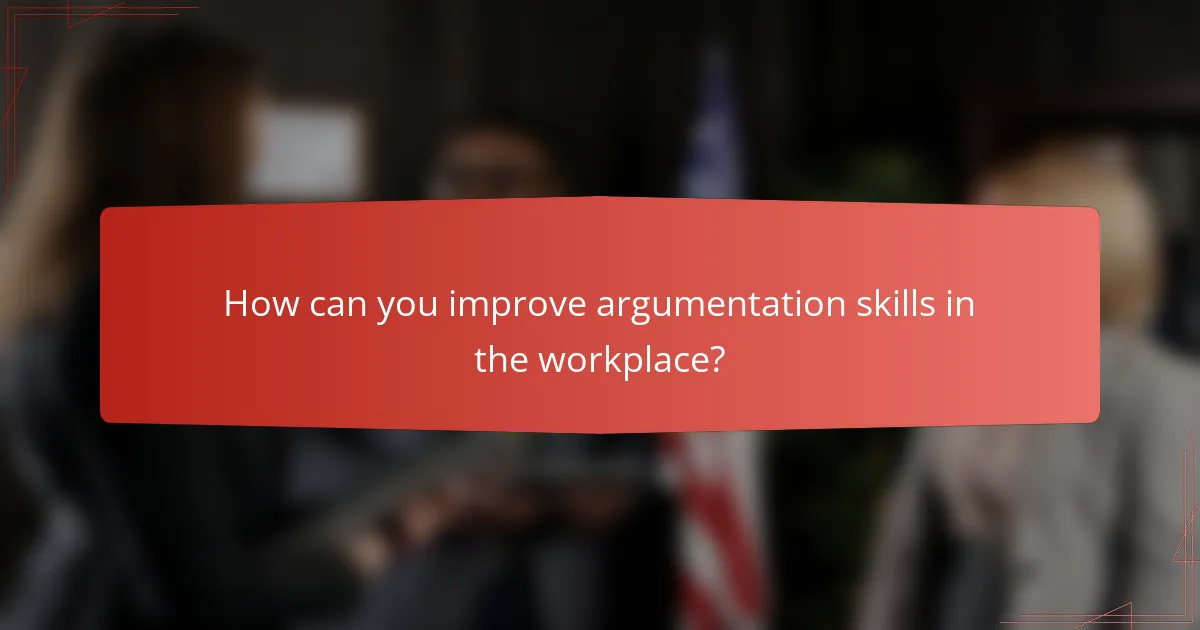
How can you improve argumentation skills in the workplace?
Improving argumentation skills in the workplace involves enhancing your ability to present ideas clearly and persuasively. This can be achieved through active listening, practice, and seeking feedback from colleagues.
Practice active listening
Active listening is crucial for effective argumentation. It involves fully concentrating on the speaker, understanding their message, and responding thoughtfully. By doing so, you can better address concerns and strengthen your own arguments.
To practice active listening, focus on the speaker without distractions, paraphrase their points to confirm understanding, and ask clarifying questions. This approach not only improves your comprehension but also builds rapport with colleagues.
Engage in role-playing exercises
Role-playing exercises can significantly enhance your argumentation skills by simulating real workplace scenarios. These exercises allow you to practice presenting your arguments and responding to counterarguments in a safe environment.
Consider organizing sessions where team members take on different roles, such as a presenter and a challenger. This dynamic helps you develop quick thinking and adaptability, essential traits for effective argumentation.
Attend workshops on persuasive communication
Workshops focused on persuasive communication provide valuable insights and techniques to improve your argumentation skills. These sessions often cover essential topics like structuring arguments, using evidence effectively, and understanding audience psychology.
Look for workshops offered by local business organizations or online platforms. Participating in these can expose you to diverse perspectives and practical strategies that you can apply in your workplace discussions.
Utilize feedback from peers
Seeking feedback from peers is an effective way to refine your argumentation skills. Constructive criticism can highlight areas for improvement and reinforce effective techniques you may already be using.
After presenting an argument, ask colleagues for their honest opinions on your delivery and content. Use their insights to adjust your approach in future discussions, ensuring continuous growth in your skills.
Study successful arguments in business
Analyzing successful arguments in business settings can provide practical examples of effective techniques. Look for case studies or presentations from industry leaders that showcase strong argumentation strategies.
Pay attention to how these arguments are structured, the types of evidence used, and the persuasive techniques employed. This study can inspire you to adopt similar methods in your own workplace arguments, enhancing your overall effectiveness.
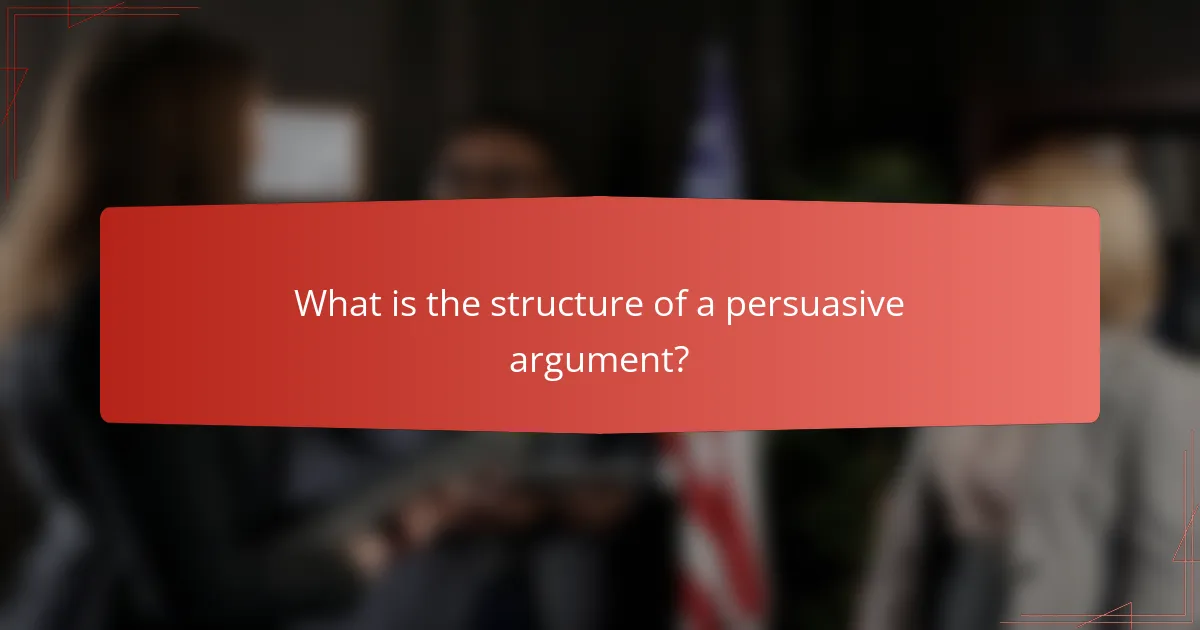
What is the structure of a persuasive argument?
The structure of a persuasive argument typically includes an introduction with a clear thesis, a logical progression of ideas, counterarguments and rebuttals, and a conclusion summarizing key points. This framework helps to effectively communicate ideas and persuade the audience.
Introduction with a clear thesis
The introduction sets the stage for your argument by presenting a clear thesis statement. This statement should encapsulate your main point and provide a roadmap for your argument.
A strong thesis is specific and debatable, allowing for discussion and analysis. For example, instead of stating, “Climate change is bad,” a more effective thesis would be, “Immediate action is necessary to combat climate change to prevent severe economic and environmental consequences.”
Logical progression of ideas
After the introduction, the argument should unfold logically, with each idea building on the previous one. This progression helps the audience follow your reasoning and understand how each point supports your thesis.
Use clear topic sentences at the beginning of each paragraph to signal the main idea. For instance, if discussing the economic impacts of climate change, start with a sentence that highlights the financial stakes involved, then provide supporting evidence and examples.
Counterarguments and rebuttals
Addressing counterarguments strengthens your position by demonstrating that you have considered opposing views. Acknowledge these viewpoints respectfully and provide rebuttals that reinforce your thesis.
For example, if critics argue that climate action is too costly, you could counter by presenting data showing that the long-term savings from preventing climate-related disasters outweigh initial investments. This approach not only shows depth in your argument but also enhances credibility.
Conclusion summarizing key points
The conclusion should succinctly summarize the key points made throughout the argument, reinforcing the thesis. This is your final opportunity to persuade the audience, so make it impactful.
Restate the importance of your argument and suggest a call to action. For instance, you might conclude with, “To secure a sustainable future, we must prioritize climate action now, ensuring economic stability and environmental health for generations to come.”

What types of evidence strengthen arguments?
Strong arguments are bolstered by various types of evidence that enhance credibility and persuasiveness. The most effective evidence includes statistical data, expert testimonials, case studies, and historical examples, each serving to substantiate claims and influence the audience’s perspective.
Statistical data from reputable sources
Statistical data provides quantifiable evidence that can significantly strengthen an argument. Using statistics from reputable sources, such as government reports or academic studies, lends authority to claims and helps to illustrate trends or patterns. For instance, citing that “over 70% of consumers prefer eco-friendly products” can effectively support a case for sustainable practices.
When incorporating statistics, ensure they are relevant and up-to-date. Avoid cherry-picking data that only supports your argument; instead, present a balanced view that acknowledges counterarguments. This approach enhances your credibility and fosters trust with your audience.
Expert testimonials and endorsements
Expert testimonials and endorsements serve as powerful evidence by leveraging the authority of recognized figures in a field. When an expert shares their insights or supports a claim, it can significantly influence public perception and acceptance. For example, a renowned scientist endorsing a new health product can sway consumer trust and interest.
To effectively use expert testimonials, select individuals who are well-respected and relevant to your argument. Ensure their credentials are clear and that their endorsement is genuine, as any perceived insincerity can undermine your argument’s strength.
Case studies demonstrating success
Case studies provide real-world examples that illustrate the effectiveness of a particular approach or solution. By detailing specific instances where a strategy has succeeded, you can offer tangible proof that resonates with your audience. For instance, a case study showing how a company increased sales by 50% through a new marketing strategy can effectively support your argument.
When presenting case studies, focus on clear outcomes and relevant metrics. Highlight the challenges faced, the actions taken, and the results achieved to create a compelling narrative that engages your audience.
Historical examples relevant to the argument
Historical examples can enrich an argument by providing context and demonstrating how similar situations have unfolded in the past. Drawing parallels between historical events and current issues can help clarify your points and make them more relatable. For instance, referencing past public health campaigns can illustrate the potential impact of current health initiatives.
When using historical examples, ensure they are directly relevant to your argument and clearly articulated. Avoid overly complex narratives; instead, focus on key events and their implications to maintain clarity and engagement with your audience.
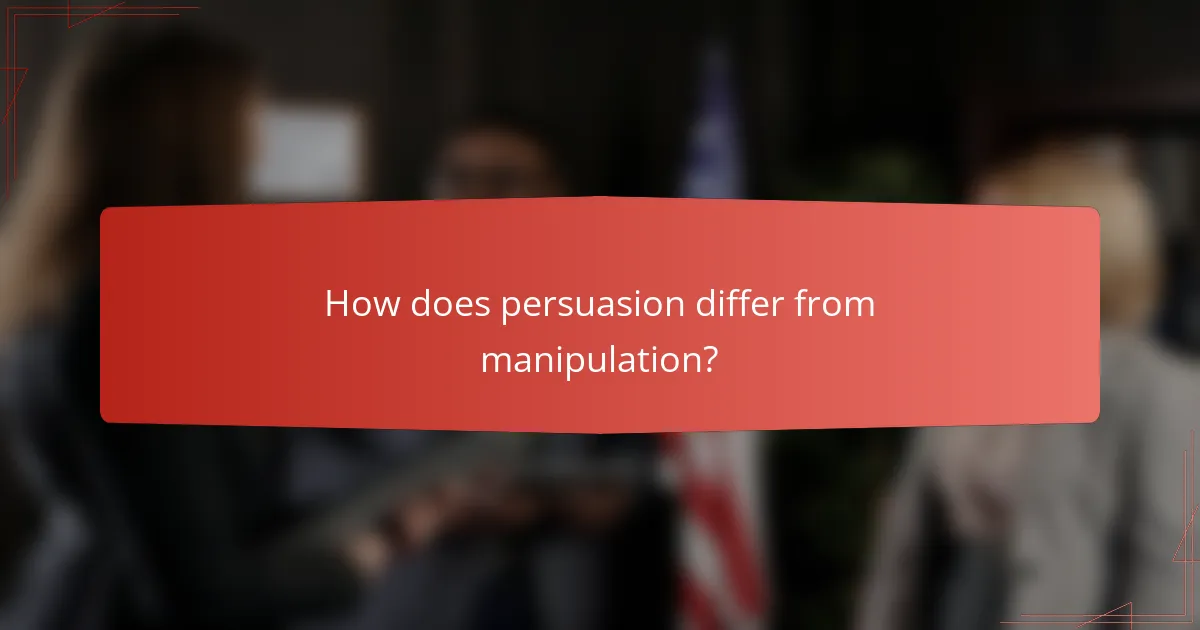
How does persuasion differ from manipulation?
Persuasion and manipulation are distinct in their approaches to influencing others. While persuasion seeks to convince individuals through reason and respect for their choices, manipulation often involves deceit or coercion to achieve a desired outcome.
Persuasion respects the audience’s autonomy
Persuasion acknowledges the audience’s right to make their own decisions. It involves presenting information clearly and allowing individuals to weigh the options based on their values and beliefs. For example, a salesperson might provide detailed product benefits and let the customer decide without pressure.
This respect for autonomy fosters trust and encourages open dialogue, which can lead to more meaningful connections. When people feel their choices are valued, they are more likely to engage positively with the persuader.
Manipulation exploits emotional vulnerabilities
Manipulation takes advantage of an individual’s emotional weaknesses to achieve its goals. This can involve using guilt, fear, or false promises to coerce someone into a decision. For instance, a manipulative tactic might involve exaggerating the consequences of not complying with a request, creating undue pressure.
Such tactics can lead to resentment and a breakdown of trust. Recognizing manipulation is crucial; individuals should be wary of situations where they feel cornered or overly emotional about a decision.
Persuasion aims for mutual benefit
Persuasion seeks outcomes that are advantageous for both parties involved. It focuses on finding common ground and creating solutions that satisfy the needs of all stakeholders. For example, in a negotiation, both sides might discuss their priorities to reach a compromise that benefits everyone.
This approach not only enhances relationships but also promotes long-term cooperation. When both parties feel they have gained something, it builds a foundation for future interactions and trust.

What frameworks can guide effective argumentation?
Effective argumentation can be guided by structured frameworks that enhance clarity and persuasion. These frameworks help in organizing thoughts, presenting evidence, and addressing counterarguments, making the argument more compelling.
Rogerian argument structure
The Rogerian argument structure emphasizes understanding and empathy between opposing viewpoints. This approach seeks common ground rather than confrontation, making it particularly useful in emotionally charged discussions.
To implement this structure, start by acknowledging the opposing viewpoint, then present your perspective while highlighting areas of agreement. This method encourages collaboration and can lead to more productive conversations.
For example, in a debate about climate change, instead of outright dismissing skeptics, one might acknowledge concerns about economic impacts while advocating for sustainable solutions that benefit both the environment and the economy. This approach fosters dialogue and reduces defensiveness.
